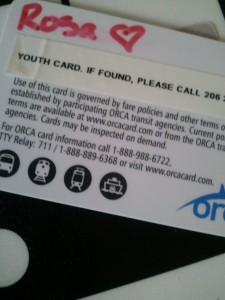Last November, our Chicklet turned six—and entered the world of fare-paying riders. As with many aspects of taking transit with children, this transition has presented some logistical challenges.
In an ideal world, Bus Nerd and I would be able to pay for Chicklet with our own ORCA cards.* Unfortunately, that is not an option. Not surprisingly, it isn’t possible to load two passes onto one card. And, though each of us has both a pass and a supplementary “e-purse”** loaded on our cards, it’s not possible to use the pass for the adult fare and the e-purse for the child fare. At least, we haven’t found a driver who thinks it’s possible; the request seems to baffle them.
The last thing we want is drama and confusion (and holding folks up!) every time we board a bus with our kid, so, we decided to “simplify” by buying Chicklet an ORCA card of her own. The thing is, simplifying’s not so simple.
First of all, buying the pass was a hassle. FYI folks: You can’t buy a youth ORCA card just anywhere; you will have to schelp downtown during business hours. And make sure to bring your kid’s birth certificate. No proof of age, no pass. At the time I purchased Chicklet’s card, I worked downtown, so I went to Metro’s pass sales office–with the necessary documents, thanks to knowledge gained helping a young friend some years ago–during lunch.
Because Chicklet’s daily commute is a walk, she doesn’t ride the bus enough to justify a pass. So, I loaded the card with twenty dollars. (The total cost was twenty-five, since the card itself costs five dollars. Don’t get me started.) Later that day, I logged on to ORCA site, registered the card, and set up autoload to add $10 whenever she ran out of money.
Chicklet was really, really excited to get her own card. (Though I’m not sure she liked it as much as this one.) We wrote her name on the back in black sharpie, and she used it for the first time on a trip to the Seattle Center to meet up with some lifelong friends. It took her a couple of tries to get the hang of tapping (and to figure out what the different beeps mean), but within days, she was wielding that card like a pro.
Yay! Except…
Chicklet has no place to keep a transit card. At six, she does not carry a wallet or purse and only carries her backpack to school. I anticipated this issue and so bought her a lanyard with a card holder when I bought her the card.
The lanyard is a great place to store the card (and has the added bonus of providing a place for us to keep the school ID she never needs), but it doesn’t address the more critical six-year-old challenge: She isn’t the best at keeping up with stuff.***
In the interest of not losing (or having to remember) it, I carry the lanyard in my bus bag, which I always have with me. When we go somewhere on the bus, I get it out of my bag; she wears it while she needs it, then gives it back to me.
We still don’t have a solution, other than buying another card, for when she travels with her dad. Sometimes, we remember to do the card hand-off in advance. Most of the time, we don’t. And, despite my precautionary measures, we have already managed to lose one card.
The details of the loss are not important–especially since we still have no idea how it occurred. What is important is that, after a week of paying cash, hoping it would resurface, I made another trek to the Metro offices.
The first place I visited was the lost and found. Despite the fact that her name was written on the back, the man at the desk said he could not look for the card without the eight-digit card number. Of course, I had no clue what the card number was. And, of course, he could not look it up from his desk. For that, I had to visit the pass sales office.
The woman at the pass sales office was able to look up Chicklet’s card, and when she did, she discovered that it was not a youth card but an adult card. (Apparently, it is common for youth cards to mysteriously get converted to adult cards when an adult loads money on the card online. And also, no one really knows how to prevent this from happening.) So, even if I found the card, Chicklet would not be able to use it. (Apparently, despite all this unintentional online card-flipping, there is no way to intentionally, with the help of Metro staff, convert an adult card to a youth card.) She recommended that I purchase another card.
I did buy another card, but unfortunately, the woman I was working with was not able to transfer the balance from Chicklet’s lost card to her new card. (The person authorized to do that was away at lunch.) She registered the new card for me, in hopes it would prevent the inexplicable youth/adult mix-up (she was doing her best to help, bless her heart), and promised that my balance would be transferred by the end of the day.
A month later, the balance has not been transferred. But, so far, weeks after I set up autoload online, the new card is still registered as a youth card. And so far, we’ve managed to keep track of it.
But I’ve taken a few additional precautionary measures, just in case.
*******
*Actually, in an ideal world transit would be free. This would just be a decent scenario in the very broken world we live in.
**An e-purse is an electronic account from which a fare is deducted every time you use it.
***For context: She has managed–more than once–to lose a pair of glasses that were attached to her face.



It is mindboggling how convoluted, user unfriendly and just plain confusing ORCA is. I doubt whoever is responsible for it’s design ever had the misfortune to have to use the system. They are probably driving around in a Hummer everywhere. Then there is the confusion about where and how you tap depending on which transit mode you are using. Money loaded online takes forever to show up, and doesn’t show up online until you tap. They went out of their way to discourage people from wanting to use it. To top it all off, you have to pay $5 for the privilege? Plus, who ya gonna call to complain? They just point their finger back at the agencies, but which agency can help you solve these general problems? I wish I knew. My sympathies for your pain.
Kathy, I completely agree with everything you said. The cost of the card is infuriating–and a barrier for many people. Metro & ST are all but forcing folks to use ORCA (by making transit more expensive for those who don’t), and then, as you said, charging them $5 to do it. On top of that, getting a card is confusing and difficult. And, as you said, there’s no accountability. Which agency do I complain to when something is confusing or difficult? ORCA doesn’t care and doesn’t answer to us.
It’s funny, this started as a post about the difficulties of figuring out how to pay for a child on the bus, but it turned into a half-rant about how ridiculous ORCA is. One day I will devote an entire post to my “issues” with our fare system.
I agree that the fare structure needs to be more eqbltauie. For example, I can ride the 342 from Shoreline down to Renton and pay a single zone fare or I can get to Renton via Seattle and pay two-zones for a trip takes twice as long. However, making a complex fare structure probably requires a move to proof-of-payment aka honor system. The task of enforcing fares needs to be taken off the drivers and placed in the hands of fare inspectors. I don’t want to see drivers arguing with passengers on the correct fare, slowing things down and causing trouble.Many European transit systems use distance-based fares in the form of many small zones. They also use the proof-of-payment system, on rail and even on buses since the late 1960s. Enforcement is key to success. Portland tried it on their buses in the 80s and it was a failure because their enforcement was weak and the equipment broke down often. One of the reasons they wanted to do POP was to make the fare structure more eqbltauie by having more zones.Here’s a bit of history about Metro fare zones1973: Originally, Metro set fares at 20 cents base and 10 cents for each additional zone, and there were 30 different zones that the buses traveled through. In 1977, the agency moved to the simpler two-zone system.So there’s your distance-based system. I don’t know how it performed though.I don’t think ORCA will be a problem for tourists as long as they set up a system for returning cards. When I was in Singapore I got a stored-value card with a deposit and then returned it for my deposit.
Some of the requirements (money loaded online taking 24+ hours to show up) are reasonable ways to save money. (Imagine if every bus had to have every online transaction transmitted to it over the cell network. It’d be an insanely expensive proposition.) But they’re really poorly communicated.
Other things (like not being able to load two passes) are just a failure of imagination on the part of whoever gathered the requirements for ORCA.
The cost of the card is horrible. At most it should be $2.50 since thats about what it costs the agencies. They never made money off the old fare media, they shouldn’t make it off the ORCA card.
is true. However, Metro has attempted FARE FREE caucrlitors that would have/should have taken people short to medium distances to do what they must (I’m thinking Ballard LINK for all you vets). The fact of the matter is that Seattle is just as American as any other city there will need to be a cultural revolution before masses take transit, regardless of fare or lack thereof.
(1) Sneaky how you tucked the poor into that quesoitn. I don’t see income as a barrier to a smart card. How I’d deal with the rest is the standard fare system. No ORCA card? Maximum fare.(2) How about we put the back scanner outside the back door? Enter front, leave front or back. Yes, swipe on and off. I’m fine with getting rid of the ride free zone if we have a distance based fare nobody will mind paying a dime or two.
Oh wow that’s really to bad they make it so hard just to get and keep the same pass. Its like they don’t actually want anyone on transit.
Even when I had a job and commuted the whole 2.5 miles dwontwon, and couldn’t carpool for a few months, the bus pass would have cost me an extra . Now, being a stay-at-home dad until the economy picks up? That’s $72 a month that can be used on food.I live close to 5 separate lines and a bus pass doesn’t make sense for me. The reason? Our rates are really set up for long-distance daily bus commuters or people without cars.